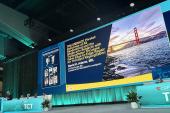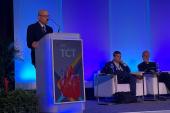Tricuspid TEER Continues to Offer Benefits Through 3 Years: TRILUMINATE
Results from the single-arm trial are the longest systematic follow-up to date, but experts are looking to the future.

Tricuspid transcatheter edge-to-edge repair (T-TEER) with the TriClip device (Abbott) continues to offer sustained benefits 3 years after the intervention in patients with symptomatic moderate or greater tricuspid regurgitation (TR), final results from the TRILUMINATE single-arm trial show.
The data represent the longest follow-up to date for T-TEER and offer good news in terms of TR reduction, symptoms, quality of life, and heart failure hospitalizations, researchers report.
Senior author Rebecca T. Hahn, MD (NewYork-Presbyterian/Columbia University Irving Medical Center, New York, NY), told TCTMD the new findings confirm that TriClip has durable effects. But she also specified that when comparing among the studies that have come thus far—such as the TRILUMINATE Pivotal trial and recently reported Tri.Fr—context is important.
The initial TRILUMINATE study tested only the first-generation TriClip NT device and did not involve a control arm, Hahn noted. Its participants also were sicker, with more to gain in terms of function and quality of life, and the observed mortality rate was higher than in the randomized trials, which thus far have shown no impact on hard outcomes like death.
What’s clear now is that TriClip “is a great device that can reduce the regurgitation down to mild or moderate in a large percentage of patients,” she commented. In about half of TriClip-treated patients “you will get the ideal outcome, which is a reduction to mild or less,” a level that registry data have linked to better survival. Bringing residual TR down to moderate still is helpful in improving quality of life, added Hahn.
As reported by TCTMD, the specifics of T-TEER’s role in patient management—and how it will be reimbursed—are salient given the US Food and Drug Administration approval of TriClip in April 2024.
Durable TR Reductions
Hahn, along with lead author Georg Nickenig, MD (University Hospital Bonn, Germany), and colleagues, initially enrolled 98 patients (mean age 77.5 years; 66% women) with symptomatic moderate or greater TR in the international prospective, single-arm study.
By 3 years, information about TR severity was available for 48 patients, of whom 79% had achieved a reduction to moderate or less TR (P = 0.001 vs baseline). The majority (92%) had a decrease of at least one grade, and TR severity held steady between 1 and 3 years.
Details on NYHA class and Kansas City Cardiomyopathy Questionnaire (KCCQ) were available for 54 patients. Between baseline and 3 years, the proportion of patients categorized as NYHA class III/IV dropped from 76% to 19% (P < 0.0001), though there were no changes after 1 year. For KCCQ, the mean score improved from 53.8 at baseline to 75.8 at 1 year, then decreased to 63.7 at 3 years (P = 0.0001 vs 1 year). Still this represented an overall improvement from baseline to 3 years of 10 points (P = 0.006).
Site-reported heart failure hospitalizations went down by 86% with the intervention, from 0.43 events/patient-year in the year before T-TEER to 0.05 events/patient-year in the year after (P < 0.0001). Three-year event rates were 27% for mortality, 10% for major bleeding, 4% for stroke, 2% for new pacemaker implantation, and 1% for new-onset liver failure.
Patients whose TR was reduced to moderate or less at 30 days were, in comparison to those whose TR stayed at severe or greater, less likely to have a heart failure hospitalization or die by 3 years (30.7% vs 50.7%; P = 0.026).
Echocardiographic assessments done by a core laboratory showed sustained remodeling of the right heart, with a decrease in mean RV end-diastolic dimension at 3 years (from 5.3 cm at baseline to 4.9 cm; P = 0.0001) and no significant change between 1 and 3 years.
“Additional analyses are needed to further understand the progression of tricuspid disease and the role that concomitant disease processes play in long-term patient outcomes,” the investigators write. “However, our encouraging 3-year results justify and warrant these further controlled studies on T-TEER in patients with severe, symptomatic TR, particularly in light of the favorable safety profile and the lack of other treatment options.”
They point out that the TriClip NT used in TRILUMINATE differs from the current TriClip G4 system, which features longer clips and the ability to independently grasp individual leaflets during placement. Moreover, as noted by Hahn, TriClip is not the only T-TEER contender: also under study is the Pascal system (Edwards Lifesciences).
Teasing Out Effects
Hahn said a key question going forward is how the trajectory of patients’ TR compares with what happens with the natural history of the disease if left untreated. Within the TRILUMINATE population, she noted, there are three patient groups: the 38% with no change in TR severity by 3 years, the 44% with further TR reduction during that time, and the 19% who in fact had an increase in TR.
“Whether or not the 44% of patients [who continued to get] better actually got better related to the clip, I think is somewhat questionable, since we know that there is a natural history regression and progression rate,” Hahn explained, referring to a 2024 paper in JACC: Cardiovascular Imaging that showed a similar distribution for progression without T-TEER.
TriClip performs well at reducing TR and has a “tremendous” effect on quality of life, Hahn added, but T-TEER is “probably not going to be the only tool in the toolbox. We need other tools that may be able to affect a more consistent reduction without as many anatomic restrictions.” She cited the potent TR reduction seen with Evoque (Edwards Lifesciences) transcatheter tricuspid valve replacement as an example.
In an accompanying editorial, Domenico Angellotti, MD (Bern University Hospital, Switzerland, and University of Naples Federico II, Italy) and Fabien Praz, MD (Bern University Hospital), also draw attention to the unknowns of T-TEER.
These include “1) the optimal time point for an intervention; 2) result durability and long-term response; and 3) the net clinical benefit compared with medical therapy alone,” they write. “Elucidating these points appears crucial to ensure the sustainability of this emerging field and to best help patients.”
The 3-year follow-up data are thus welcome, Angellotti and Praz say, but “further research will soon elucidate the net clinical impact of T-TEER and hopefully bring light into the lives of the patients suffering from the consequences of TR.” Trials to keep an eye on include the recently presented Tri.Fr as well as the ongoing TRACE-NL, CLASP II TR, and TRICI-HF studies.
Hahn cautioned that it may be hard to draw a link between TR treatment and survival. “Clearly, right heart disease and tricuspid valve disease play a role in outcomes for any disease process. [But] trying to separate out the individual component of mortality that is related to just TR reduction is difficult, and that's what we attempted to do in the trials,” she said.
Through their investigations, though, “I think we've learned something valuable, which is that [TR reduction is] highly related to symptoms and quality of life,” Hahn said, adding that if there is a survival benefit, “it may take many, many years” to see.
Caitlin E. Cox is News Editor of TCTMD and Associate Director, Editorial Content at the Cardiovascular Research Foundation. She produces the…
Read Full BioSources
Nickenig G, Lurz P, Sorajja P, et al. Percutaneous edge-to-edge repair for tricuspid regurgitation: 3-year outcomes from the TRILUMINATE study. J Am Coll Cardiol Intv. 2024;Epub ahead of print.
Angellotti D, Praz F. 3-Year outcomes of tricuspid transcatheter edge-to-edge repair: illuminating the path forward. J Am Coll Cardiol Intv. 2024;Epub ahead of print.
Disclosures
- This study was supported by Abbott Structural Heart.
- Nickenig reports having received research funding and honoraria from Abbott, Edwards Lifesciences, and Medtronic; and having participated in clinical trials with Abbott, Edwards Lifesciences, and Medtronic.
- Hahn reports receiving speaker fees from Abbott Structural, Baylis Medical, Edwards Lifesciences, and Philips Healthcare as well as having institutional consulting contracts for which she receives no direct compensation with Abbott Structural, Boston Scientific, Edwards Lifesciences, Medtronic, and Novartis.
- Angellotti reports no relevant conflicts of interest.
- Praz reports having received travel expenses from Edwards Lifesciences, Abbott Vascular, Medira, Siemens Healthineers, and InQB8 Medical Technologies as well as a research grant to his institution from Abbott Vascular.





Comments